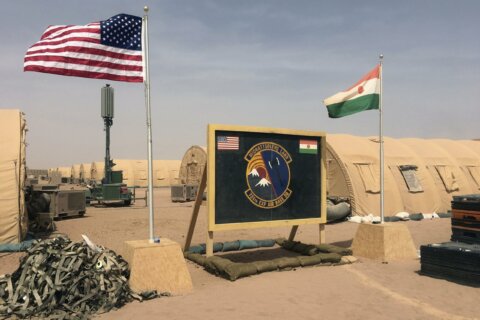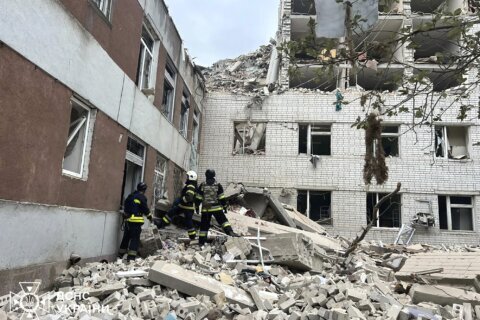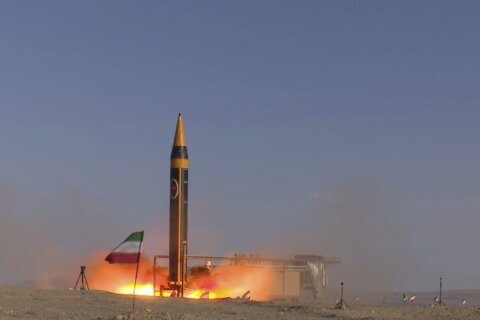WASHINGTON — As a result of withering attacks by the U.S.-led military coalition in Iraq and Syria, the Islamic State of Iraq and the Levant (ISIL) is “in a defensive crouch,” according to U.S. military officials.
But the U.S. intelligence community’s view is that ISIL still has two big advantages: numbers and the element of surprise.
“Two things keep me up at night,” U.S. National Counterterrorism Center Director Nicholas Rasmussen told WTOP in an exclusive interview. “Both are directly related to ISIL’s proven ability, using the Internet to radicalize and instruct people, here inside the U.S., to launch attacks.”
“One is that the possibility of an attack here inside the homeland by a group of networked operatives from a foreign terrorist organization who somehow may have escaped our intelligence community’s collection,” said Rasmussen.
According to a U.S. law enforcement official, the San Bernardino attackers who killed 14 people and wounded 22 others on Dec. 2 planned the attack while essentially living a double life.
Rasmussen’s other concern is “the continued threat to our aviation sector.”
“One only has to look overseas to see some of the incidents that have happened with aircraft -bombings attempted bombings -to realize, that remains a continuing and persistent vulnerability,” he said.
He was referring to the downing of Metro Jet flight 9268 on Oct. 31. It broke up in-flight over Egypt’s Sinai, after a bomb was detonated aboard killing all 224 passengers.
Within an hour of the crash, ISIL took responsibility. After several days, Russian and western authorities expressed certainty it was likely an ISIL-sponsored terror attack. ISIL later posted a picture of the device it claimed was used in one of its publications.
In early February, a suicide bomber was blown out of a Daallo Airlines flight leaving Mogadishu airport in Somalia. The attacker was sucked out of a hole in the plane, after detonating an explosive device inside a laptop at 11,000 feet. His body was found later on the ground. The other 73 passengers onboard survived and the crew managed to land the plane.
Authorities around the world are concerned that those successes have emboldened terrorist to outdo each other.
TSA Administrator Peter Neffenger told WTOP the agency is “paying very close attention to our processes, procedures and technologies designed to detect items that could harm an aircraft, damage an aircraft or destroy an aircraft.”
Terrorism experts say that since the Metrojet crash, terrorists are becoming more skillful at creating bombs and slipping them past security. And Neffenger said the TSA has seen evidence of a developing competition among terrorists.
Neffenger said events in the past few months have made it clear that the threat to aviation in certain countries is much higher than at any time in recent years and “that competition means that the environment is a little more uncertain than it was before.”
“From an intelligence perspective, we see terrorist groups continuing to aspire to carry out those kinds of attacks. And I don’t envy my colleagues and partners with responsibility for aviation security because they have one of the most difficult jobs there is,” said Rasmussen.
The difficulty, he said is being right 100 percent of the time.
“They can do everything right in 99.9 percent of the locations around the world where we are dealing with the traveling public, and it’s that one-tenth of one percent vulnerability that keeps me up at night.”
Despite his concerns, Rasmussen said the agency and the intelligence community, as a whole, have made significant progress.
“We’ve had great success over time at constraining the capability of al-Qaida (as a centralized organization) to carry out large, mass-casualty attacks potentially here in the homeland. I think we’ve had a great deal of success shrinking the size of that potential threat.”
But he acknowledged that today al-Qaida affiliates and ISIL are harder to handle.
“We have more terrorist actors coming at us from a more diverse array of places and locations around the globe. And that does affect our mission because we are stretched, I would argue.”
Rasmussen said the agency estimates that 38,000 people have traveled to Iraq and Syria with the intention to join the ISIL organization. It’s not clear how many of them remain because many have been killed in battle or have left the region.
The most pressing concern, he said, is the “large pool of people potentially able to carry out terrorist activities in their home areas of national origin, should they choose to return home at some point in the future.”
He said they are particularly concerned about “the subset of that 38,000; approximately 7,000 people who come from western countries.”
He estimated that among them are 250 Americans who have gone to Iraq and Syria or have tried.
Some of them he said “are on the ground fighting for one of the many extremist groups operating inside Syria right now.”
Recognizing that NCTC and other intelligence community employees are facing a grueling challenge trying to keep up with the exploding global terrorism problem, President Barack Obama paid NCTC a visit in December to applaud their efforts. Rasmussen said that visit went a long way toward attracting new people to the agency with the skills to fight what he acknowledges will be a long fight.








